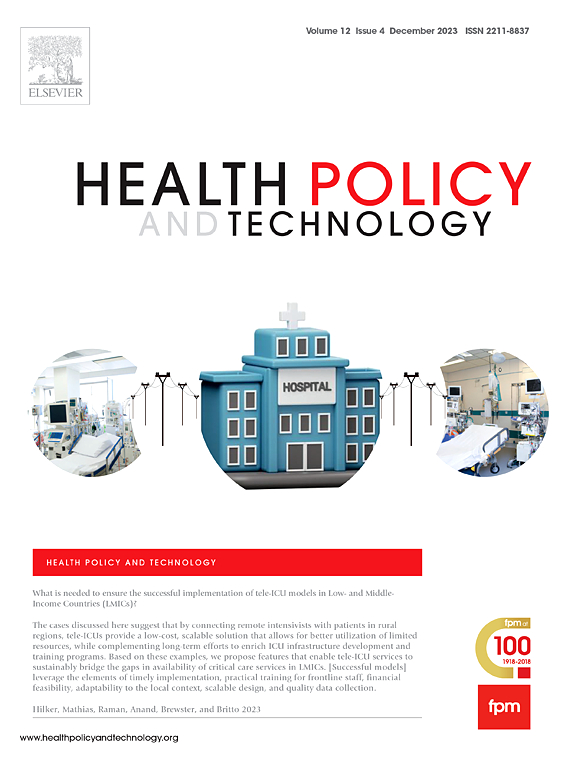Computerized clinical decision support systems for prescribing in primary care: Characteristics and implementation impact. Scoping review and evidence and gap maps
IF 3.7
3区 医学
Q1 HEALTH POLICY & SERVICES
引用次数: 0
Abstract
This study aimed to conduct a scoping review and evidence and gap maps to characterize Clinical Decision Support Systems (CDSS) in primary care, evaluate their implementation and maintenance levels, and identify evidence gaps. Methods: A literature search covering January 2010 to May 2023 was conducted across various databases. Inclusion criteria encompassed studies involving real patients with detailed descriptions of CDSS, including both comparative and descriptive designs within primary care settings. Two independent reviewers screened the references, while four researchers independently extracted data, which included demographics, main findings, and system descriptions. The results were presented using interactive evidence and gap maps. Results: Among 1,447 initial citations, 75 studies met the selection criteria. The identified types of CDSS included adherence to guidelines/local protocols (45 %), antibiotic prescription (16 %), suitability (15 %), and others. Only one system was classified as "intelligent," while 39 % received a complexity rating of 4 on a scale from 1 to 5. Assessment of various outcomes across the studies revealed health outcomes (20 %), economy/resource use (13 %), potentially inappropriate prescription (61 %), adherence to local guidelines/protocols (12 %), and acceptance/use (40 %). Two maps were created: The first one displayed the type of CDSS linked to the type of results measured. The second one showed the type of CDSS and their most relevant characteristics. Data were represented in a dynamic bubble diagram. Conclusion: Current evidence regarding CDSS in primary care is limited and heterogeneous. The identified systems exhibit relative complexity but are not classified as intelligent, primarily focusing on improving prescribing practices through clinical guidelines or prescription aid tools. The outcomes most frequently assessed included potentially inappropriate prescriptions and acceptance/use. The evidence and gap maps provide a user-friendly format for visualizing existing evidence and identifying research gaps in the implementation of CDSS within primary care.
Systematic Review registration: This study is registered in Open Science Framework. https://bit.ly/2RqKrWp
Results data: EGMs: The complete EGMs can be accessed at the following link: https://proyectos.imibic.org/evidence-map/
初级保健处方的计算机化临床决策支持系统:特点和实施影响。范围审查,证据和差距图
本研究旨在进行范围审查和证据和差距图,以表征初级保健中的临床决策支持系统(CDSS),评估其实施和维护水平,并确定证据差距。方法:检索各数据库2010年1月至2023年5月的文献。纳入标准包括有CDSS详细描述的真实患者的研究,包括初级保健设置中的比较和描述性设计。两名独立审稿人筛选参考文献,四名研究人员独立提取数据,包括人口统计、主要发现和系统描述。使用交互式证据和差距图展示了结果。结果:1447篇初始引用中,有75篇符合入选标准。确定的CDSS类型包括遵守指南/当地方案(45%)、抗生素处方(16%)、适用性(15%)等。只有一个系统被归类为“智能”,而39%的系统在1到5的范围内获得了4分的复杂性评级。对研究中各种结果的评估显示,健康结果(20%)、经济/资源利用(13%)、可能不适当的处方(61%)、遵守当地指南/方案(12%)和接受/使用(40%)。创建了两个地图:第一个显示了与测量结果类型相关联的CDSS类型。第二部分显示了CDSS的类型及其最相关的特征。数据用动态气泡图表示。结论:目前关于CDSS在初级保健中的应用的证据是有限的和异质性的。已确定的系统表现出相对的复杂性,但未被归类为智能,主要侧重于通过临床指南或处方辅助工具改善处方实践。最常评估的结果包括可能不适当的处方和接受/使用。证据和差距图提供了一种用户友好的格式,用于将现有证据可视化,并确定在初级保健中实施CDSS的研究差距。系统评价注册:本研究已在开放科学框架中注册。https://bit.ly/2RqKrWpResults data: egm:完整的egm可通过以下链接访问:https://proyectos.imibic.org/evidence-map/
本文章由计算机程序翻译,如有差异,请以英文原文为准。
求助全文
约1分钟内获得全文
求助全文
来源期刊

Health Policy and Technology
Medicine-Health Policy
CiteScore
9.20
自引率
3.30%
发文量
78
审稿时长
88 days
期刊介绍:
Health Policy and Technology (HPT), is the official journal of the Fellowship of Postgraduate Medicine (FPM), a cross-disciplinary journal, which focuses on past, present and future health policy and the role of technology in clinical and non-clinical national and international health environments.
HPT provides a further excellent way for the FPM to continue to make important national and international contributions to development of policy and practice within medicine and related disciplines. The aim of HPT is to publish relevant, timely and accessible articles and commentaries to support policy-makers, health professionals, health technology providers, patient groups and academia interested in health policy and technology.
Topics covered by HPT will include:
- Health technology, including drug discovery, diagnostics, medicines, devices, therapeutic delivery and eHealth systems
- Cross-national comparisons on health policy using evidence-based approaches
- National studies on health policy to determine the outcomes of technology-driven initiatives
- Cross-border eHealth including health tourism
- The digital divide in mobility, access and affordability of healthcare
- Health technology assessment (HTA) methods and tools for evaluating the effectiveness of clinical and non-clinical health technologies
- Health and eHealth indicators and benchmarks (measure/metrics) for understanding the adoption and diffusion of health technologies
- Health and eHealth models and frameworks to support policy-makers and other stakeholders in decision-making
- Stakeholder engagement with health technologies (clinical and patient/citizen buy-in)
- Regulation and health economics
 求助内容:
求助内容: 应助结果提醒方式:
应助结果提醒方式:


